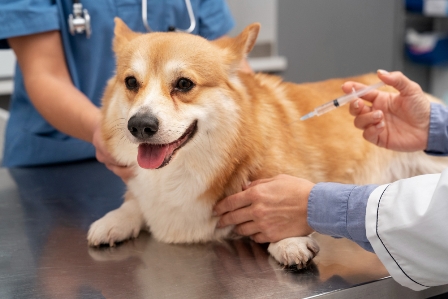Welcome to our comprehensive guide on how to determine if your beloved furry friend has a fever. As pet owners, we understand how crucial it is to take care of our dogs’ health and well-being. A fever in dogs can be a sign of an underlying health issue that requires attention and care. In this article, we’ll explore the various signs and symptoms of a dog fever, what causes it, and the steps you can take to provide the best care for your canine companion.

1. Understanding Dog Fever
A dog fever, also known as pyrexia, occurs when your dog’s body temperature rises above the normal range, which is typically between 100.5°F and 102.5°F (38°C to 39.2°C). It’s essential to recognize the signs of a fever as early as possible to ensure prompt veterinary attention and appropriate treatment.
As a responsible pet owner, it is crucial to monitor your dog’s health and well-being regularly. One common health concern that dogs may face is having a fever. Since dogs can’t express how they feel verbally, it’s essential for you, as a pet parent, to be vigilant and look for signs that may indicate your furry friend has a fever. Here are some key pointers to help you identify if your dog is running a fever:
2. Symptoms of Dog fever
2.1. Elevated Body Temperature:
The most apparent sign of a fever in dogs is an elevated body temperature. A dog’s normal body temperature usually ranges between 99.5°F and 102.5°F (37.5°C to 39.2°C). You can use a rectal thermometer to take your dog’s temperature, but be gentle and cautious while doing so. If their temperature surpasses the normal range, it may be a sign of a fever.
2.2. Lethargy and Weakness:
When dogs have a fever, they often feel weak and lethargic. You may notice that your dog is less energetic than usual, reluctant to play or go for walks, and prefers to rest more often. This lack of enthusiasm and reduced activity level can be an indication that something is not quite right with their health.
2.3. Loss of Appetite:
A fever can cause a loss of appetite in dogs. If your dog suddenly becomes disinterested in their favorite treats or food and is not eating as much as they usually do, it could be a sign that they are not feeling well.
2.4. Shivering or Trembling:
Dogs may shiver or tremble when they have a fever as their body tries to regulate its temperature. If your dog is experiencing chills or noticeable trembling, it’s essential to pay attention and monitor them closely.
2.5. Warm or Dry Nose:
Contrary to the popular belief that a warm nose always indicates sickness, a dog’s nose can vary in temperature throughout the day. However, a consistently warm and dry nose, along with other symptoms, could be a sign of a fever.
2.6. Red or Swollen Eyes:
In some cases, a fever may cause your dog’s eyes to appear red or swollen. If you notice any unusual changes in their eyes, it’s best to consult a veterinarian.
2.7. Increased Heart Rate and Panting:
Fever can lead to an increased heart rate and excessive panting in dogs. If you observe your dog’s heart rate is abnormally high or they are panting excessively without any apparent reason, it’s advisable to seek professional veterinary advice.
If you suspect that your dog may have a fever, it’s crucial to consult your veterinarian promptly. A professional evaluation will help determine the underlying cause of the fever and guide you on the appropriate treatment and care for your beloved furry companion. Always remember that early detection and timely medical attention can play a vital role in ensuring your dog’s health and well-being.
3.Causes of Dog Fever
3.1. Infections
Infections are the most common cause of fevers in dogs. Bacterial, viral, or fungal infections can lead to a rise in body temperature as the body’s immune system fights off the invaders.
3.2. Inflammatory Conditions
Inflammatory conditions like arthritis, pancreatitis, or inflammatory bowel disease can cause fevers in dogs. These conditions trigger an immune response, leading to elevated body temperatures.
3.3. Vaccination
In some cases, dogs may experience a mild fever after receiving vaccinations. This is usually a short-lived response and not a cause for concern unless other severe symptoms accompany it.
3.4. Heatstroke
Hot weather or prolonged exposure to high temperatures can cause heatstroke in dogs, leading to a fever. Heatstroke is a medical emergency and requires immediate attention.
3.5. Tumors
Though less common, certain tumors in dogs can produce pyrogens that induce fever.
4. When to Seek Veterinary Care

As a responsible and caring dog owner, knowing when to seek veterinary care for your furry companion is of utmost importance. While some minor health issues can be managed at home, certain signs and symptoms require immediate attention from a qualified veterinarian. Here are some key situations when you should seek veterinary care for your dog:
4.1. Difficulty Breathing:
If your dog is experiencing difficulty breathing, it is a serious emergency that requires immediate veterinary attention. Labored breathing, choking, wheezing, or gasping for breath could be indicative of various underlying health issues and must not be ignored.
4.2. Persistent Vomiting and Diarrhea:
Occasional vomiting or diarrhea may not be unusual, but if your dog is continuously vomiting or having severe diarrhea for more than a day, it’s time to consult a veterinarian. These symptoms can lead to dehydration and may indicate an underlying illness or ingestion of something harmful.
4.3. Uncontrolled Bleeding:
In the event of severe injuries or uncontrolled bleeding, immediate veterinary care is necessary. Apply pressure to the wound and seek professional help as soon as possible to prevent further complications.
4.4. Severe Lethargy and Weakness:
If your dog is extremely lethargic, weak, and unresponsive, it could be a sign of a severe health issue. Such lethargy is different from normal tiredness after physical activity, and immediate veterinary evaluation is vital to identify the underlying cause.
4.5. Ingestion of Toxic Substances:
If you suspect your dog has ingested something toxic, such as certain foods, plants, chemicals, or medications meant for humans, contact a veterinarian or an emergency animal poison control center immediately. Quick action is essential to prevent poisoning complications.
4.6. Prolonged Loss of Appetite:
A dog refusing to eat for an extended period can be a worrisome sign. If your dog’s loss of appetite persists, it may indicate an underlying health problem that requires professional evaluation.
4.7. Persistent Pain or Discomfort:
Dogs may try to hide their pain, but if you notice your furry friend showing signs of discomfort, such as whimpering, yelping, or reluctance to move, it’s best to have them examined by a veterinarian to identify the source of pain.
4.8. Change in Behavior:
Sudden and significant changes in your dog’s behavior, such as aggression, confusion, or disorientation, warrant a veterinary visit. These behavioral changes may be indicative of underlying medical or emotional issues.
4.9. Eye or Ear Problems:
Redness, swelling, discharge, or persistent scratching of the eyes or ears may indicate an infection or injury that requires veterinary care.
4.10. Difficulty Urinating or Defecating:
If your dog is having trouble urinating or defecating, it could be a sign of urinary or gastrointestinal problems that need to be addressed by a veterinarian.
Remember, your dog’s health and well-being are your responsibility as a pet owner. If you notice any of the mentioned signs or any other abnormal behavior, do not hesitate to seek professional veterinary care. Early intervention can make a significant difference in your dog’s recovery and overall quality of life. Always prioritize the well-being of your furry companion and ensure they receive the best possible care when needed.
5. Can fever causes the death of a beloved dog ?
Yes, fever can potentially cause the death of a beloved dog if left untreated or if it is associated with a severe underlying condition. Fever itself is not usually life-threatening; it is often a symptom of an underlying illness or infection. However, if the fever is not addressed promptly, the condition causing it can progress, leading to serious complications that may be fatal.
When a dog has a fever, it indicates that their body is fighting off an infection or dealing with an inflammatory response. Infections can be caused by bacteria, viruses, or fungi, and if left untreated, they can spread and become more severe. Inflammatory conditions can also worsen if not properly managed, leading to further health issues.
In some cases, a dog may develop a fever due to heatstroke, which can be life-threatening if not treated immediately. Heatstroke occurs when a dog’s body temperature rises to dangerous levels due to prolonged exposure to high temperatures or being confined in a hot environment. This can lead to organ failure and, ultimately, death.
As responsible pet owners, it is crucial to monitor our dogs’ health closely and seek veterinary care if they show any signs of illness or have a fever. Prompt medical attention can help identify the underlying cause of the fever and allow for appropriate treatment. Providing timely care can significantly improve the chances of a positive outcome and prevent potential life-threatening complications.
Remember, if you suspect your dog has a fever or any other health issue, always consult with a veterinarian for professional advice and guidance. Your veterinarian can provide the necessary care and treatment to ensure the well-being of your beloved canine companion.
6. What precaution should be taken for our beloved dog ?

Ensuring the well-being of our beloved dogs involves taking several important precautions to keep them healthy, happy, and safe. Here are some essential precautions every dog owner should consider:
6.1 Regular Veterinary Check-ups:
Schedule regular check-ups with a veterinarian to monitor your dog’s overall health and catch any potential issues early on.
6.2 Vaccinations:
Keep your dog’s vaccinations up to date to protect them from various contagious diseases.
6.3 Proper Nutrition:
Provide a balanced and nutritious diet suitable for your dog’s age, size, and breed. Avoid feeding them harmful human foods like chocolate, grapes, onions, and others that can be toxic to dogs.
6.4 Hydration:
Always provide fresh and clean water for your dog to stay properly hydrated.
6.5 Exercise and Mental Stimulation:
Regular exercise is essential for your dog’s physical and mental well-being. Engage them in playtime and provide mental stimulation through interactive toys and puzzles.
6.6 Grooming:
Regularly groom your dog, including brushing their coat, trimming their nails, and cleaning their ears, to keep them clean and comfortable.
6.7 Parasite Prevention:
Use appropriate flea, tick, and heart worm prevention methods to protect your dog from parasites that can cause health issues.
6.8 Safe Environment:
Create a safe living space for your dog, free of hazards and toxic substances. Secure your yard and home to prevent accidents or escapes.
6.9 Socialization:
Socialize your dog with other dogs and people from an early age to ensure they are well-adjusted and friendly.
6.10 Training:
Proper training is essential for your dog’s safety and behavior. Teach basic commands and leash manners to keep them under control.
6.11 Identification:
Ensure your dog wears a collar with an ID tag containing your contact information. Consider microchipping as an added layer of identification.
6.12 Temperature Awareness:
Be mindful of extreme weather conditions, whether hot or cold, and take appropriate measures to protect your dog from heatstroke or hypothermia.
6.13 Travel Safety:
If traveling with your dog, secure them properly in a crate or use a dog seatbelt to prevent injuries during car rides.
6.14 Avoid Overexertion:
Be cautious not to over-exercise young or elderly dogs, as this can lead to injuries and health problems.
6.15 Observe Behavior Changes:
Pay attention to any changes in your dog’s behavior, appetite, or energy levels, as they can be signs of underlying health issues.
6.16 Avoid Exposure to Harmful Substances:
Keep household chemicals, medications, and toxic plants out of reach to prevent accidental poisoning.
By taking these precautions and providing your beloved dog with love, care, and attention, you can ensure they lead a happy and healthy life as an integral part of your family. Always remember that the safety and well-being of your canine companion are in your hands, and responsible pet ownership is essential for their long-term happiness.
7. How should I care for a dog during fever?

Caring for a dog during a fever requires attentive and nurturing care to help them recover and alleviate their discomfort. Here are some essential steps to take when your dog has a fever:
7.1 Monitor Their Temperature:
Keep track of your dog’s temperature regularly using a rectal thermometer. Consult with your veterinarian to determine the appropriate temperature range for your dog’s breed and size.
7.2 Isolate and Rest:
Create a quiet and comfortable space for your dog to rest and recover. Isolating them from other pets and minimizing noise and activity can help reduce stress and promote healing.
7.3 Hydration:
Ensure your dog has access to fresh and clean water at all times. A fever can lead to dehydration, so encourage them to drink regularly.
7.4 Appetite and Nutrition:
Monitor your dog’s appetite and offer them easily digestible, nutritious meals. If they are not eating, try offering small, frequent meals or tempting them with special treats.
7.5 Cool Environment:
Keep your dog in a cool environment to help lower their body temperature. Use fans or air conditioning, especially during hot weather.
7.6 Wet Towel Compress:
Dampen a towel with cool (not cold) water and gently place it on your dog’s paws, ears, and forehead. This can help cool them down.
7.7 Medication (if prescribed):
Follow your veterinarian’s instructions regarding any prescribed medications for the fever. Never give human medications to dogs without professional guidance.
7.8 Keep Calm:
Your dog may be feeling weak and uncomfortable during their fever. Keep interactions calm and gentle, and avoid strenuous activities.
7.9 Contact Your Veterinarian:
If the fever persists or if your dog’s condition worsens, contact your veterinarian immediately. They can provide guidance on potential underlying causes and recommend appropriate treatment.
7.10 Avoid Overheating:
Avoid exposing your dog to direct sunlight or hot temperatures, as this can exacerbate their fever and lead to heatstroke.
7.11 Comfort and Reassurance:
Offer your dog comfort and reassurance through gentle petting and soothing words. Your presence can help reduce their stress and anxiety.
7.12 Keep Them Clean:
If your dog has discharge from their eyes or nose, gently clean it with a soft, damp cloth to prevent irritation and infection.
Remember that a fever is often a symptom of an underlying issue, and it’s crucial to address the root cause. While you can provide care and comfort at home, consulting with a veterinarian is essential to ensure proper diagnosis and treatment. Your veterinarian will be able to identify the cause of the fever and recommend appropriate steps to help your dog recover fully.
Always prioritize your dog’s health and well-being, and seek professional veterinary care if you have any concerns about their condition.
FAQs
Here are some frequently asked questions along with their concise answers: How to know if Dog has fever
No, you cannot reliably tell if a dog has a fever by touch alone. Feeling a dog’s skin or nose may give a general sense of warmth, but it is not a definitive method for accurately determining if they have a fever. The most accurate way to detect a fever in a dog is by using a rectal thermometer to measure their body temperature. If you suspect your dog has a fever, it’s essential to consult with a veterinarian for proper diagnosis and appropriate care.
Use a Thermometer:Use a digital rectal thermometer specifically designed for pets. Lubricate the tip with petroleum jelly and gently insert it into your dog’s rectum. Hold it in place for about a minute.
Normal Range: A dog’s normal body temperature ranges from 99.5°F to 102.5°F (37.5°C to 39.2°C).
Fever: If the temperature exceeds the normal range, it may indicate a fever. Consult your veterinarian for further evaluation and advice.
No, you cannot reliably tell if a dog has a fever by touch alone.
No, dog fever typically cannot spread directly to humans.
Conclusion
Your dog’s health is of utmost importance, and recognizing the signs of a fever early can make a significant difference in their well-being. By understanding the symptoms and potential causes of a fever in dogs, you can take timely action and provide the care and attention your beloved companion needs. Remember, if you suspect your dog has a fever or any other health issue, always consult with a veterinarian for professional advice and guidance.